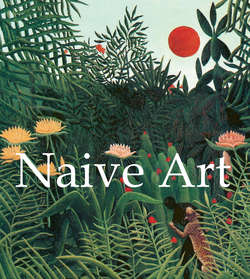Читать книгу Naive Art - Nathalia Brodskaya - Страница 4
Reflections on Naïve Art
Оглавление‘Naïve’ art, and the artists who created it, became well known in Europe at the beginning of the twentieth century. Who were these artists, and what was their background? To find out, we have to turn back the clock and look at the history of art at that time. It is interesting that for much of the intervening century, the Naïve artists themselves seem to have attracted rather less attention than those people responsible for ‘discovering’ them or publicizing them.
The Representatives of Foreign Powers Coming to Greet the Republic as a Sign of Peace
Henri Rousseau, 1907
Oil on canvas, 130 × 161 cm
Musée Picasso, Paris
Yet that is not unusual. After all, the Naïve artists might never have come into the light of public scrutiny at all if it had not been for the fascination that other young European artists of the avant-garde movement had for their work – avant-garde artists whose own work has now, at the turn of the millennium, also passed into art history.
View from the Bridge of Sèvres and the Hills of Clamart and Bellevue
Henri Rousseau, 1908
Oil on canvas, 80 × 120 cm
Pushkin Museum of Fine Arts, Moscow
In this way we should not consider viewing works by, say, Henri Rousseau, Niko Pirosmani, Ivan Generalic, André Bauchant or Louis Vivin without reference at the same time to the ideas and styles of such recognized masters as Pablo Picasso, Henri Matisse, Joan Miró, Max Ernst and Mikhail Larionov.
Father Juniet’s Cart
Henri Rousseau, 1908
Oil on canvas, 97 × 129 cm
Musée de l’Orangerie, Paris
But of course, to make that reference itself presents problems. Who was influenced by whom, in what way, and what was the result? The work of the Naïve artists poses so many questions of this kind that experts will undoubtedly still be trying to unravel the answers for a good time yet.
In the Rain Forest
Henri Rousseau, 1908
Oil on canvas, 46 × 55 cm
The Hermitage, St Petersburg
The main necessity is to establish for each of the Naïve artists precisely who or what the main source of their inspiration was. This has then to be located within a framework expressing the artist’s relationship to the ‘classic’ academic (‘official’) art of the period.
Guillaume Apollinaire and Marie Laurencin
Henri Rousseau, 1909
Oil on canvas, 200 × 389 cm
The Hermitage, St Petersburg
Difficult as it is to make headway in such research, matters are further complicated by the fact that such questions may themselves have more than one answer – and that each answer may be subject to different interpretation by different experts anyway. It gets worse. All the time the works of previously unknown Naïve artists are coming to light, some of them from the early days of Naïve art, some of them relatively contemporary.
View on the Fortifications, from the Left of the Vanves Gate
Henri Rousseau, 1909
Oil on canvas, 31 × 41 cm
The Hermitage, St Petersburg
Their art may add to our understanding of the phenomenon of Naïve art or may change it altogether. For this reason alone it would simply not be feasible to come to an appreciation of Naïve art that was tightly-defined, complete and static.
The Spell
Henri Rousseau, 1909
Oil on canvas, 45.5 × 37.5 cm
Museum Charlotte Zander, Bönnigheim Castle
In this study, therefore, we will contemplate only those outstanding – yet outstandingly diverse – examples of Naïve art that really do constitute pointers towards a genuine style, a genuine direction in pictorial representation, albeit one that is currently little known. Think of this book, if you like, as a preliminary sketch for a picture that will be completed by future generations.
Romanian Painting
It is difficult – perhaps even impossible – to quantify the influence of Henri Rousseau, Niko Pirosmani and Ivan Generalic on professional ‘modern’ artists and the artworks they produce. The reason is obvious: the three of them belonged to no one specific school and, indeed, worked to no specific system of art.
A Negro Attacked by a Panther
Henri Rousseau, ca. 1910
Oil on canvas, 114 × 162 cm
Museum of Arts, Basle
It is for this reason that genuine scholars of Naïve art are somewhat thin on the ground. After all, it is hard to find any basic element, any consistent factor that unites their art and enables it to be studied as a discrete phenomenon. The problems begin even in finding a proper name for this kind of art.
Notre-Dame-de-Paris
André Duranton
No single term is descriptive enough. It is all very well consulting dictionaries – they are not much use in this situation. A dictionary definition of a ‘primitive’ in relation to art, for example, might be ‘An artist or sculptor of the period before the Renaissance’.
Horse Attacked by a Jaguar
Henri Rousseau, 1910
Oil on canvas, 89 × 116 cm
Pushkin Museum of Fine Arts, Moscow
Конец ознакомительного фрагмента. Купить книгу
